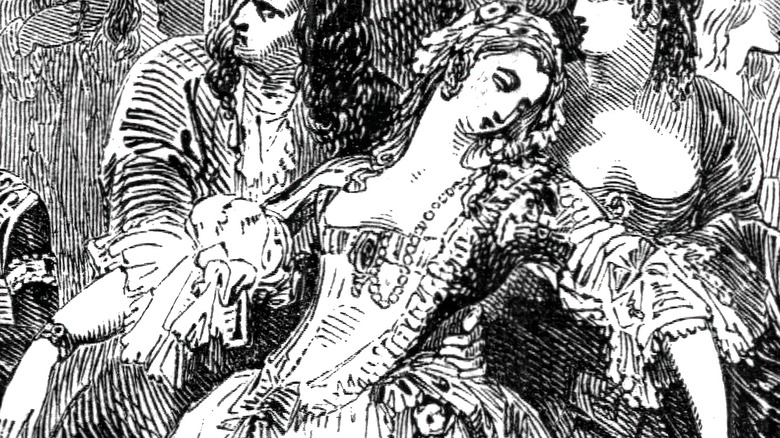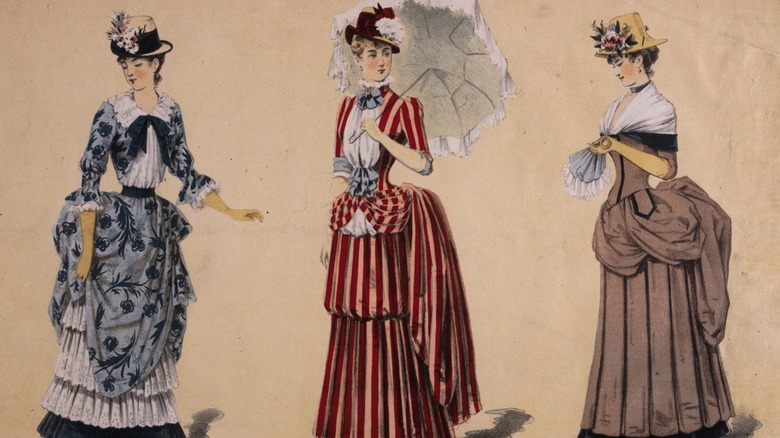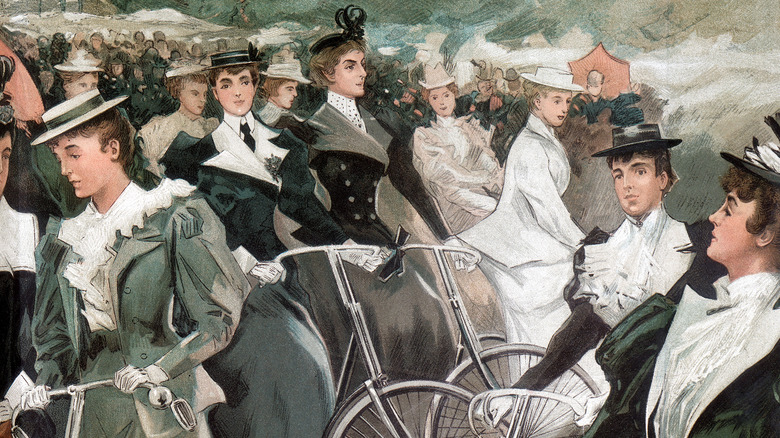The Myth About Victorian Women You Can Stop Believing
Picture a Victorian woman. She probably has a penchant for bicycles, she sports exaggerated shoulder sleeves, and fears showing her ankles (British Library and Bustle). Describing Victorian women as constantly fainting from a life of wearing constricting corsets can also be tempting. And Victorian beauty ideals indeed included delicacy and frailty, writes The Journal of Psychology. Fainting was considered an appropriately feminine act. Swooning women were familiar figures in Victorian literature and popular culture, per the Journal of Victorian Culture. However, corsets may not be the cause of the fainting Victorian woman.
It's important to parse the Victorian woman's lived experiences from how she is portrayed in fiction to understand her reality. In fact, the reality of Victorian women's fainting has not undergone rigorous study, observes Victoria Bates in the Journal of Victorian Culture, and it was often a common phenomenon in court proceedings possibly invoked to garner the sympathy of jurors. Here's what we do know.
Corsets didn't make Victorian women faint
According to The Journal of Psychology, many blame the corset for the fainting Victorian woman. However, women wore corsets for over 400 years before the fainting Victorian woman says Lancaster History's Stephanie Celiberti. She points out that we don't have reports of fainting episodes caused by the garments during those periods. The Vintage Woman Magazine explains that corsets helped support women who wore heavy fabrics and layers rather than giving them small waists. While narrow waists were in style, hip padding and oversized sleeves helped create the illusion of a tiny waist.
Corsets also offered bust support similar to modern-day underwire bras, Celiberti writes. Women of all social classes wore corsets, which meant they had to be flexible to function in manual labor. Corsets were tailor-made to the individual and also adjustable to aid in comfort. The Victorian trend of "tightlacing" appeared in the mid-1800s but was an option rather than the norm.
Victorian women constricted by corsets collapsing onto fainting couches is another popular image, but that too is a myth. The Atlanta Journal-Constitution explains that what we know as "fainting couches" were daybeds meant for men and women to rest during the day without disturbing the bed coverings. Similarly, "fainting rooms," the small closet-less rooms in Victorian Houses held the daybeds rather than fainting couches. Residents used the rooms for periodic resting rather than swooning spells, reports William Kibbel III, a Home Inspector (via Old House Web).
Women still faint more than men
So who began blaming corsets for faint women? It turns out that male doctors puzzled by medical conditions they didn't understand perpetuated the myth, explains The Vintage Woman Magazine. It was easy to blame a piece of clothing commonly associated with women. While they were wrong about the ailment and the cause, those doctors may have been observing a natural phenomenon that occurs to this day. Scientifically, women appear to faint more than men, reports The Journal of Psychology.
Unfortunately, even today, the higher frequency of women fainting can lead to incorrect assumptions that come from a place of misogyny. Endocrinologist Dr. Roisin Worsley explains, "Because it affects young women, I think it's often seen as being hysterical rather than biological," SBS. Recent studies have pointed out that those of the female sex experience lower blood pressure than those of the male sex. Iron deficiency, more common in women, could also be a factor. Researchers have not yet identified one cause for women fainting more than men, says The Journal of Psychology. While there is still much to learn about the fainting women of today and the Victorian era, we can cut the corset some slack.


